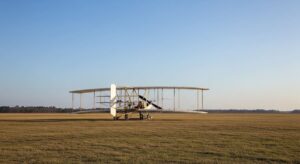Air traffic control (ATC) is one of the most complex and responsibility-heavy roles in the aviation sector. Every flight that takes off and lands safely does so with the help of skilled controllers keeping a constant watch on aircraft movements. However, with air traffic increasing steadily across global skies, including over India’s crowded air routes, traditional ATC systems are under growing pressure.
To handle this scale with precision, the aviation industry is now turning to artificial intelligence (AI) for support, not to replace humans, but to assist them in making quicker, data-driven and safer decisions. From managing crowded skies to preventing near-miss situations, AI is stepping into areas once handled entirely by human judgement.
Easing the Burden on Human Controllers
Air traffic controllers work under intense pressure. They must monitor multiple aircraft, ensure proper separation, manage runway occupancy and make quick decisions, all without room for error. AI helps by taking over repetitive tasks and flagging abnormal patterns faster than a human could.
For example, AI tools can automatically detect if an aircraft is deviating from its assigned altitude or path. Instead of manually tracking every movement, controllers get alerts, allowing them to focus on the bigger picture. This type of support doesn’t replace the controller’s role; it strengthens it by providing early warnings and reducing fatigue caused by information overload.
Smarter Traffic Flow Management
Congestion in the air and on runways is a major issue at busy airports like Delhi, Mumbai, Ahmedabad and Bengaluru. AI-powered systems are now being used to better sequence arrivals and departures. These tools analyse weather patterns, aircraft types, runway availability and past traffic trends to suggest optimal timings for take-offs and landings.
By doing this, AI reduces holding patterns, saves fuel and helps airlines stick to their schedules. A smoother flow also improves the passenger experience. In fact, some airports have reported noticeable drops in delays and missed connections after introducing AI-supported traffic flow systems.
Predictive Analytics for Better Planning
Air traffic controllers usually depend on scheduled flight data and real-time radar feeds. But AI adds another layer: prediction. With historical data and real-time inputs from multiple sources, AI systems can forecast air traffic hours in advance. If a storm is expected to impact a region, AI can predict how many flights will be affected and suggest rerouting strategies ahead of time.
These predictive models also help in staffing. Knowing how much air traffic to expect allows for better deployment of controllers, reducing the risk of understaffed control towers during peak hours.
Voice Recognition and Communication Assistance
Clear communication between pilots and air traffic controllers is critical. However, heavy accents, technical terms and background noise can sometimes lead to misunderstandings. AI-driven voice recognition tools are now being trained to transcribe and interpret pilot-controller conversations in real-time.
These systems can flag discrepancies between what was instructed and what is being executed. For instance, if a pilot repeats an incorrect altitude due to a misunderstood command, the AI system can detect the mismatch and notify the controller. This reduces the chances of errors stemming from miscommunication.
Enhancing Safety with Pattern Detection
AI is particularly effective at detecting patterns and anomalies. In air traffic control, this capability can be life-saving. AI tools can analyse thousands of flight paths to identify early signs of potential conflict. For example, if two aircraft are projected to cross paths in close proximity, the system can flag this well before it becomes a risk.
It can also detect risky patterns over time, like a certain air corridor experiencing more close calls than others, helping authorities re-evaluate procedures or training. In a domain where proactive safety measures are critical, AI’s role is proving highly valuable.
Support in Emergency Situations
When emergencies arise, whether due to bad weather, technical faults or medical issues, controllers have to act fast. AI systems can assist by instantly pulling up relevant information: nearest diversion airports, real-time weather conditions, runway availability and airspace status. With this information on hand, controllers can provide faster and more informed instructions to pilots.
During emergency landings, AI can even help simulate potential outcomes of different rerouting choices, giving controllers a decision-making edge that is both time-sensitive and accurate.
Real-Time Airport Surface Monitoring
Airports today resemble tightly choreographed ecosystems with aircraft, vehicles and personnel moving constantly. AI-based surveillance tools, including computer vision and radar analytics, can track ground movement in real time. These systems identify unauthorised access, detect foreign objects on runways and track aircraft on taxiways, reducing the risk of ground collisions.
At some international airports, AI-integrated cameras have significantly improved ground safety and coordination between ground staff and tower control.
Summing Up
Artificial Intelligence is not revolutionising air traffic control overnight, but it is making a quiet, steady impact. From reducing controller workload to preventing near-miss incidents and improving air traffic flow, AI is becoming an integral part of how modern skies are managed. In a country like India, where air traffic is expanding quickly, adopting AI can mean safer skies, fewer delays and better passenger experiences.











